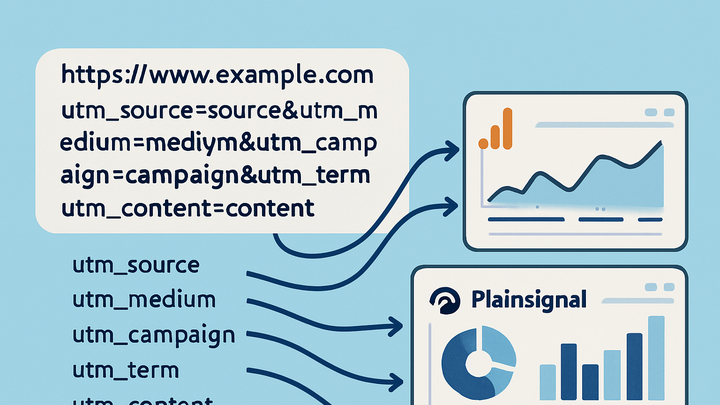Published on 2025-06-22T10:12:52Z
What is a UTM Campaign? Examples and Best Practices
A UTM Campaign refers to the use of specific URL parameters that track the performance of marketing links across various channels. By appending UTM parameters such as utm_source, utm_medium, and utm_campaign to a URL, analytics platforms capture where and how traffic arrives at your site. UTM Campaigns enable marketers to attribute conversions, clicks, and other engagements to particular campaigns, ads, or outreach efforts. These parameters are recognized by most analytics tools, including Google Analytics 4 and PlainSignal, allowing consistent cross-channel reporting without relying on proprietary tracking cookies. Proper implementation ensures that each traffic source is accurately recorded, supporting data-driven marketing decisions.
Utm campaign
A UTM Campaign uses URL parameters to track and attribute marketing efforts across channels like email, social, and ads.
What is a UTM Campaign?
A UTM Campaign refers to the use of specific URL parameters that track the performance of marketing links across various channels. By appending UTM parameters to a URL, analytics platforms capture where and how traffic arrives, enabling precise attribution of conversions and engagements to specific campaigns. This approach works consistently across tools like Google Analytics 4 and PlainSignal without relying on proprietary cookies. UTM Campaigns form the backbone of campaign reporting, ensuring marketers can measure ROI and optimize channel investment.
-
Definition of utm campaign
A UTM Campaign is a tagged URL designed to capture key campaign parameters, enabling precise tracking of marketing efforts across analytics platforms.
-
Core utm parameters
UTM Campaign tracking relies on five main parameters that provide context about the traffic source, medium, campaign, term, and content.
-
Utm_source
Identifies the referrer such as google, facebook, or newsletter.
-
Utm_medium
Specifies the marketing medium like email, cpc, banner, or social.
-
Utm_campaign
Denotes the name of the campaign, such as spring_sale or new_feature_launch.
-
Utm_term
Used for paid search campaigns to track specific keywords.
-
Utm_content
Distinguishes similar content or links within the same ad, such as logolink or textlink.
-
How UTM Campaign Tracking Works
When a user clicks on a URL containing UTM parameters, the embedded analytics snippet reads these parameters from the query string and logs them in the analytics database. In Google Analytics 4, the gtag.js or Google Tag Manager automatically picks up UTM values, populating standard campaign dimensions. PlainSignal, with its cookie-free approach, also reads UTM parameters at page load and stores them in session memory to attribute events to the correct campaign. Both methods allow subsequent events—pageviews, conversions, custom events—to be tied back to the original campaign parameters. Below are platform-specific implementation details and example code snippets.
-
GA4 implementation
Google Analytics 4 auto-detects UTM parameters when you include the gtag.js snippet. You need to replace G-XXXXXXX with your measurement ID. Example snippet:
<script async src="https://www.googletagmanager.com/gtag/js?id=G-XXXXXXX"></script> <script> window.dataLayer = window.dataLayer || []; function gtag(){dataLayer.push(arguments);} gtag('js', new Date()); gtag('config', 'G-XXXXXXX'); </script> -
PlainSignal implementation
PlainSignal is a cookie-free analytics platform that reads UTM parameters without user tracking cookies. To implement, include the PlainSignal embed script on your site. Example snippet:
<link rel="preconnect" href="//eu.plainsignal.com/" crossorigin /> <script defer data-do="yourwebsitedomain.com" data-id="0GQV1xmtzQQ" data-api="//eu.plainsignal.com" src="//cdn.plainsignal.com/plainsignal-min.js"></script>
Benefits of UTM Campaigns
Using UTM Campaigns offers precise attribution, clearer ROI calculation, and better optimization of marketing channels. By labeling each link, marketers can distinguish between organic, paid, and referral traffic. This granular view enables A/B testing, budget allocation, and performance benchmarking for campaigns. UTM data feeds into dashboards, helping teams understand user journeys and conversion drivers. Without UTMs, traffic sources can be misclassified, leading to inaccurate reports and suboptimal decisions.
-
Improved attribution accuracy
UTM parameters ensure each visitor is correctly attributed to the original campaign, reducing ambiguity in multi-channel funnels.
-
Enhanced roi measurement
By linking clicks and conversions to specific campaigns, teams can calculate cost per acquisition and ROI directly.
-
Cross-channel comparison
UTMs provide a standard tagging framework across email, social, paid ads, and affiliates, facilitating side-by-side performance analysis.
Best Practices for UTM Campaigns
To ensure clean and reliable data, follow industry best practices when constructing UTM URLs.
-
Consistent naming conventions
Use standardized, lowercase, and hyphenated names for parameters to avoid fragmentation in reports.
-
Limit parameter variations
Avoid unnecessary utm_term and utm_content tags unless they provide actionable insights; too many variations can clutter data.
-
Centralized documentation
Maintain a shared spreadsheet or tool documenting your UTM taxonomy, approved values, and usage guidelines.
